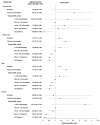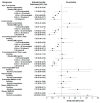Risk for Esophageal Cancer Based on Lifestyle Factors-Smoking, Alcohol Consumption, and Body Mass Index: Insight from a South Korean Population Study in a Low-Incidence Area
- PMID: 38002698
- PMCID: PMC10672319
- DOI: 10.3390/jcm12227086
Risk for Esophageal Cancer Based on Lifestyle Factors-Smoking, Alcohol Consumption, and Body Mass Index: Insight from a South Korean Population Study in a Low-Incidence Area
Abstract
Esophageal cancer constitutes a global public health challenge. However, South Korean population-specific information on the association of lifestyle (smoking, alcohol consumption, and obesity status) with esophageal cancer risk is sparse. This nested case-control study analyzed the Korean national health screening cohort data (2002-2019) of 1114 patients with esophageal cancer and 4456 controls (1:4 propensity-score matched for sex, age, income, and residential region). Conditional and unconditional logistic regression analyses, after adjustment for multiple covariates, determined the effects of lifestyle factors on esophageal cancer risk. Smoking and alcohol consumption increased the esophageal cancer risk (adjusted odds ratio [95% confidence interval]: 1.37 [1.15-1.63] and 1.89 [1.60-2.23], respectively). Overweight (body mass index [BMI] ≥ 23 to <25 kg/m2), obese I (BMI ≥ 25 to <30 kg/m2), or obese II (BMI ≥ 30 kg/m2) categories had reduced odds of esophageal cancer (0.76 [0.62-0.92], 0.59 [0.48-0.72], and 0.47 [0.26-0.85], respectively). In the subgroup analyses, the association of incident esophageal cancer with smoking and alcohol consumption persisted, particularly in men or those aged ≥55 years, whereas higher BMI scores remained consistently associated with a reduced esophageal cancer likelihood across all age groups, in both sexes, and alcohol users or current smokers. Underweight current smokers exhibited a higher propensity for esophageal cancer. In conclusion, smoking and alcohol drinking may potentially increase the risk, whereas weight maintenance, with BMI ≥ 23 kg/m2, may potentially decrease the risk, for esophageal cancer in the South Korean population. Lifestyle modification in the specific subgroups may be a potential strategy for preventing esophageal cancer.
Keywords: alcohol consumption; body mass index; cancer risk; esophageal cancer; national health screening cohort research database; smoking.
Conflict of interest statement
The authors declare no conflict of interest.
Figures




Similar articles
-
Bell's palsy and obesity, alcohol consumption and smoking: A nested case-control study using a national health screening cohort.Sci Rep. 2020 Mar 6;10(1):4248. doi: 10.1038/s41598-020-61240-7. Sci Rep. 2020. PMID: 32144385 Free PMC article.
-
[Body mass index and cancer incidence:a prospective cohort study in northern China].Zhonghua Liu Xing Bing Xue Za Zhi. 2014 Mar;35(3):231-6. Zhonghua Liu Xing Bing Xue Za Zhi. 2014. PMID: 24831616 Chinese.
-
The association between sialolithiasis and smoking, alcohol drinking and obesity in Korea: a nested case-control study.BMC Public Health. 2020 Apr 17;20(1):516. doi: 10.1186/s12889-020-08674-w. BMC Public Health. 2020. PMID: 32303215 Free PMC article.
-
Smoking Is Positively Related and Alcohol Consumption Is Negatively Related to an Increased Risk of Meniere's Disease.J Clin Med. 2022 Aug 26;11(17):5007. doi: 10.3390/jcm11175007. J Clin Med. 2022. PMID: 36078935 Free PMC article.
-
Lifestyle factors associated with obesity in a cohort of males in the central province of Sri Lanka: a cross-sectional descriptive study.BMC Public Health. 2017 Jan 5;17(1):27. doi: 10.1186/s12889-016-3963-3. BMC Public Health. 2017. PMID: 28056898 Free PMC article.
Cited by
-
The Association of Chronic Periodontitis as a Potential Risk Factor with Rheumatoid Arthritis: A Nested Case-Control Study Using a Korean National Health Screening Cohort.Biomedicines. 2024 Apr 23;12(5):936. doi: 10.3390/biomedicines12050936. Biomedicines. 2024. PMID: 38790898 Free PMC article.
-
Alcohol in Daily Products: Health Risks, Cultural Considerations, and Economic Impacts.Risk Manag Healthc Policy. 2025 Jan 18;18:217-237. doi: 10.2147/RMHP.S495493. eCollection 2025. Risk Manag Healthc Policy. 2025. PMID: 39845405 Free PMC article. Review.
-
Associations between Chronic Kidney Disease and Migraine Incidence: Findings from a Korean Longitudinal Big Data Study.J Pers Med. 2024 Mar 28;14(4):356. doi: 10.3390/jpm14040356. J Pers Med. 2024. PMID: 38672983 Free PMC article.
-
Exploring Dietary and Lifestyle Profiles in Colorectal Cancer Patients: Hypothesis-Generating Insights for Tertiary Prevention.Cancers (Basel). 2025 Aug 14;17(16):2654. doi: 10.3390/cancers17162654. Cancers (Basel). 2025. PMID: 40867283 Free PMC article.
-
Investigating the Connection between Chronic Periodontitis and Parkinson's Disease: Findings from a Korean National Cohort Study.Biomedicines. 2024 Apr 3;12(4):792. doi: 10.3390/biomedicines12040792. Biomedicines. 2024. PMID: 38672147 Free PMC article.
References
-
- Morgan E., Soerjomataram I., Rumgay H., Coleman H.G., Thrift A.P., Vignat J., Laversanne M., Ferlay J., Arnold M. The Global Landscape of Esophageal Squamous Cell Carcinoma and Esophageal Adenocarcinoma Incidence and Mortality in 2020 and Projections to 2040: New Estimates from GLOBOCAN 2020. Gastroenterology. 2022;163:649–658.e2. doi: 10.1053/j.gastro.2022.05.054. - DOI - PubMed
Grants and funding
LinkOut - more resources
Full Text Sources

